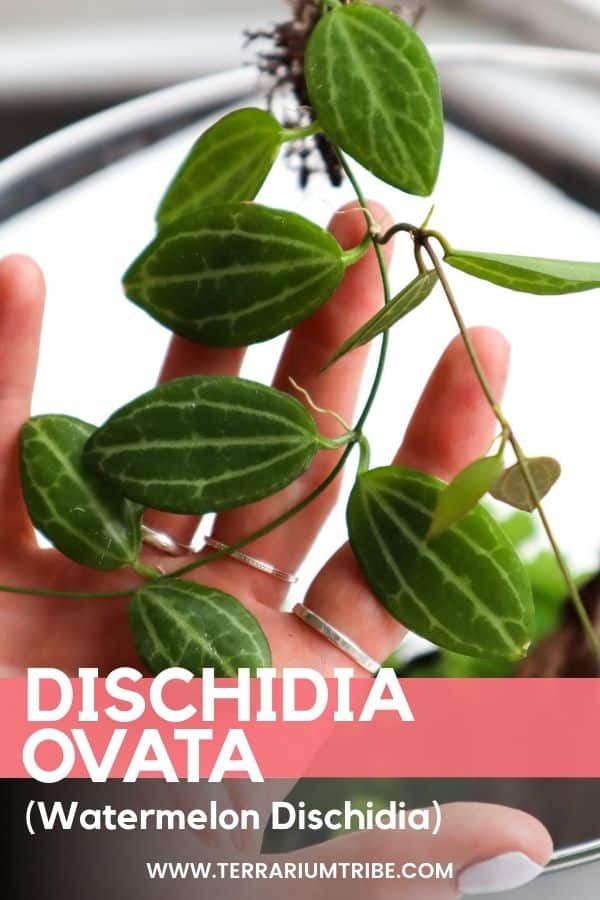Named for its deep green oval leaves with white venation, the Watermelon Dischidia really looks the part!
Native to SE Asia and Australia, this beautiful trailing plant is a lesser-known relative of the popular Hoya houseplant, but the Dischidia genus has a lot to offer, and people are starting to take notice.
Dischidia ovata is a true epiphytic plant that’s just at home in the rainforest canopy as it is in a tropical terrarium.
These cascading vines look stunning when mounted high in a terrarium (or a pot) and allowed to float their way around. They’re not an overly demanding plant and can make an easy addition to most tropical setups.

Where to Buy Dischidia ovata
See the links below to purchase from reputable terrarium plant shops and marketplaces (may include affiliate links).
Watermelon Dischidia Care & Growth
| Plant Type | Vine, epiphyte |
| Lighting | Bright, indirect light |
| Temperature | 55-90°F (12-32°C) |
| Watering | Regular, even moisture |
| Humidity | Medium – high humidity (40-90%) |
| Growth | 2-3 inches high, 3+ feet long |
Dischidia ovata Watering
The Watermelon Dischidia is a tropical plant, so unsurprisingly, it loves regular moisture.
However, just to keep you on your toes, it’s also an epiphyte. Meaning it’s used to growing on trees and branches above the ground and will not tolerate sitting in wet substrate.
Naturally, good drainage is going to be the solution here, safeguarding your plant from root rot.

For best results, try thoroughly soaking the plant when watering but allowing it to drain fully, too.
In a terrarium, the substrate should feel moist to the touch but never wet.
Substrate & Soil
The need for adequate drainage is arguably more important when choosing a soil or substrate for your plant. After all, in the wild, it’s a soil-less epiphyte.
So, if you’re planting it terrestrially, the most important thing is that the substrate provides lots of aeration and allows water to drain effectively to keep those roots happy.

Use plenty of chunky elements like orchid bark, pumice, lava rock, and charcoal in your mix to achieve this.
Of course, Dischidia ovata also does well when mounted high onto a terrarium background or hardscape.
Lighting
As it would be in its native rainforest canopy environment, Dischidia ovata thrives in bright, dappled sunlight.
Assuming you’re in the Northern Hemisphere like me, a great way to achieve this would be by popping it on a North or East-facing windowsill. If you’re in the Southern Hemisphere, the reverse would be true, making South or West-facing your best bet.
Bright, indirect light is the goal standard here; and it’ll be sure to tell you if you’re not providing this.
Too little light and your already slow-growing plant will pretty much grind to a halt, potentially with some yellowing in the leaves.

Under direct sunlight, the leaves can turn red, which is considered to be a symptom of heat stress – so consider that a red flag and move it to a shadier spot.
Another red flag? A family member who leaves your prize terrarium out in direct sun when you’re on vacation…

Temperature & Humidity
Despite being a true tropical plant, the Watermelon Dischidia is a hardier plant than you’d expect!
A good rule of thumb here is if you’re comfortable, your plant will be too.
As long as you keep things above 55°F and 40% humidity, it does just fine under regular household conditions.
That said, you’ll really see it thrive in a hot and humid environment, so why not take this opportunity to build a closed terrarium?

Watermelon Dischidia Growth & Flowers
Dischidia ovata will produce two new watermelon leaves along each stem at a time in a beautiful trailing growth habit.

To really make the most of this pattern, it’s best to mount it high so that you can enjoy its beautiful foliage.
If it’s in a pot, you can place it on a high shelf to let it cascade down.

In my experience, it’s a slow grower initially, but when properly established under ideal conditions, this plant will really get going. Feel free to trim as you deem appropriate to keep it in shape.
And if you weren’t already in love with this plant, it’s also known to bloom in summer. Its discreet bell-shaped yellow/pink flowers are gorgeous and quite reminiscent of its Hoya cousins.
I haven’t seen any yet, but my fingers are crossed!
Dischidia ovata Propagation
As with many trailing vines, propagating Dischidia ovata is incredibly easy because it roots at every node.

Meaning you can take any stem cutting that has a viable root node, and it should happily root up when wrapped in a little sphagnum moss.
In a terrarium, it’s one of those great species that you can place where you’d like it to grow (just laid on top of substrate or moss) and let it establish itself there in the humid environment.
Varieties & Similar Plants
Dischidia is an often overlooked genus of trailing plants, closely related to the much more popular Hoya plants. Dischidia ruscifolia (Million Hearts Plant), Dischidia nummularia (String of Nickels), and the lesser-known Dischidia astephana are all great choices for terrariums too.

There are other varieties of D. ovata, including Dischidia ovata ‘Round Leaf’, which (unsurprisingly) has rounded leaves rather than oval.
Alternatively, you can always stay on the watermelon train and go for the Trailing Watermelon Begonia, Pellionia repens.
